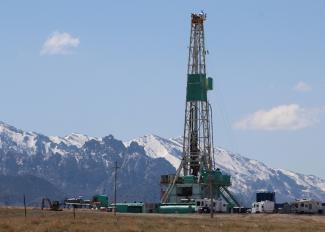The successful completion of field operations supported by NETL in southwest Utah represents a significant step forward to advance geothermal energy as a resource that will produce renewable clean electricity for the nation’s power grid.
Researchers at the Utah Frontier Observatory for Research in Geothermal Energy, also known as the Utah FORGE, used hydraulic fracturing technologies to stimulate an injection well and a parallel production well drilled at the Utah FORGE test site near the community of Milford.
Cold, non-potable water was then injected deep below the surface and heated as it flowed through an enhanced geothermal system (EGS) reservoir established in a subsurface layer of hot dry granite. The temperature of the outflow water returned to the surface via the production well was recorded at 282 degrees Fahrenheit (well above the normal boiling point of 212 degrees Fahrenheit for water). This is possible because water in the production well is flowing under pressure to the surface. Therefore, it remains in the liquid phase.
“These outstanding results are encouraging because they validate the need to further develop geothermal as a viable clean energy technology,” said Scott Beautz, an NETL petroleum engineer who is managing the Utah FORGE project in collaboration with the Energy & Geoscience Institute at the University of Utah and the U.S. Department of Energy’s Geothermal Technologies Office.
Geothermal energy has the potential to supply clean, renewable power around the clock. “Geothermal energy has a small environmental footprint and can be used to drive turbines in power plants while emitting little or no greenhouse gas. It is an important technology in our strategy to increase domestic baseload energy supply,” Beautz said.
According to the U.S. Energy Information Administration, the temperature of the Earth’s inner core is about 10,800 degrees Fahrenheit. The outer core consists of hot molten rock called magma. Temperatures in the Earth’s mantle range from about 392 degrees Fahrenheit near the mantle-crust boundary to about 7,230 degrees Fahrenheit near the mantle-core boundary. Rocks and fluids in other portions of the subsurface absorb this intense heat.
To develop an EGS reservoir, a mixture of water, chemicals and proppant is injected deep underground, which causes fractures to open. The proppant remains in those fractures, creating permeability. Increased permeability allows water to circulate throughout the now-fractured hot rock. Operators can then pump hot water up to the surface to generate electricity or heat buildings.
“In addition to providing project oversight, NETL has contributed its world-class knowledge and expertise gained by hydraulic fracturing in the oil and natural gas industry to help usher in a new era of geothermal energy,” Beautz said.
In 2020, the FORGE injection well was drilled to a measured depth of 10,897 feet. Two years later, the well was hydraulically fractured in three intervals. State-of-the-art seismic monitoring mapped the fracture networks. The production well was drilled in 2023. A brief circulation test conducted immediately following the completion of the production well revealed weak connectivity between them.
Beginning in April, commercial-scale stimulation was conducted on both wells to ensure inter-well connectivity. During the stimulation, the use of different proppants, custom fracturing plugs and treating fluids was evaluated. A total of 118,000 barrels (4,956,000 gallons) of water was injected into the subsurface for the experiment.
During a daylong circulation test, researchers reported a 70% water recovery rate, which confirmed that conductivity between the wells was established. Also, the outflow water temperature continually increased. Fiber optics data and spinner logging showed that multiple independent flow paths had been created. Also, the maximum induced seismicity during the experiment was magnitude 1.9, falling short of the threshold for felt seismicity at the surface.
Results are being analyzed and used to plan additional experiments, including a 30-day circulation test scheduled for July.
“We are excited to have had such great success during our most recent stimulation and circulation testing,” said Joseph Moore, managing principal investigator of the Utah FORGE project.
“With each success, we are another step closer to realizing the full potential of enhanced geothermal systems and the important role they will play in the world’s energy portfolio,” Beautz said.
NETL is a U.S. Department of Energy national laboratory that drives innovation and delivers solutions for an environmentally sustainable and prosperous energy future. By leveraging its world-class talent and research facilities, NETL is ensuring affordable, abundant, and reliable energy that drives a robust economy and national security, while developing technologies to manage carbon across the full life cycle, enabling environmental sustainability for all Americans.




